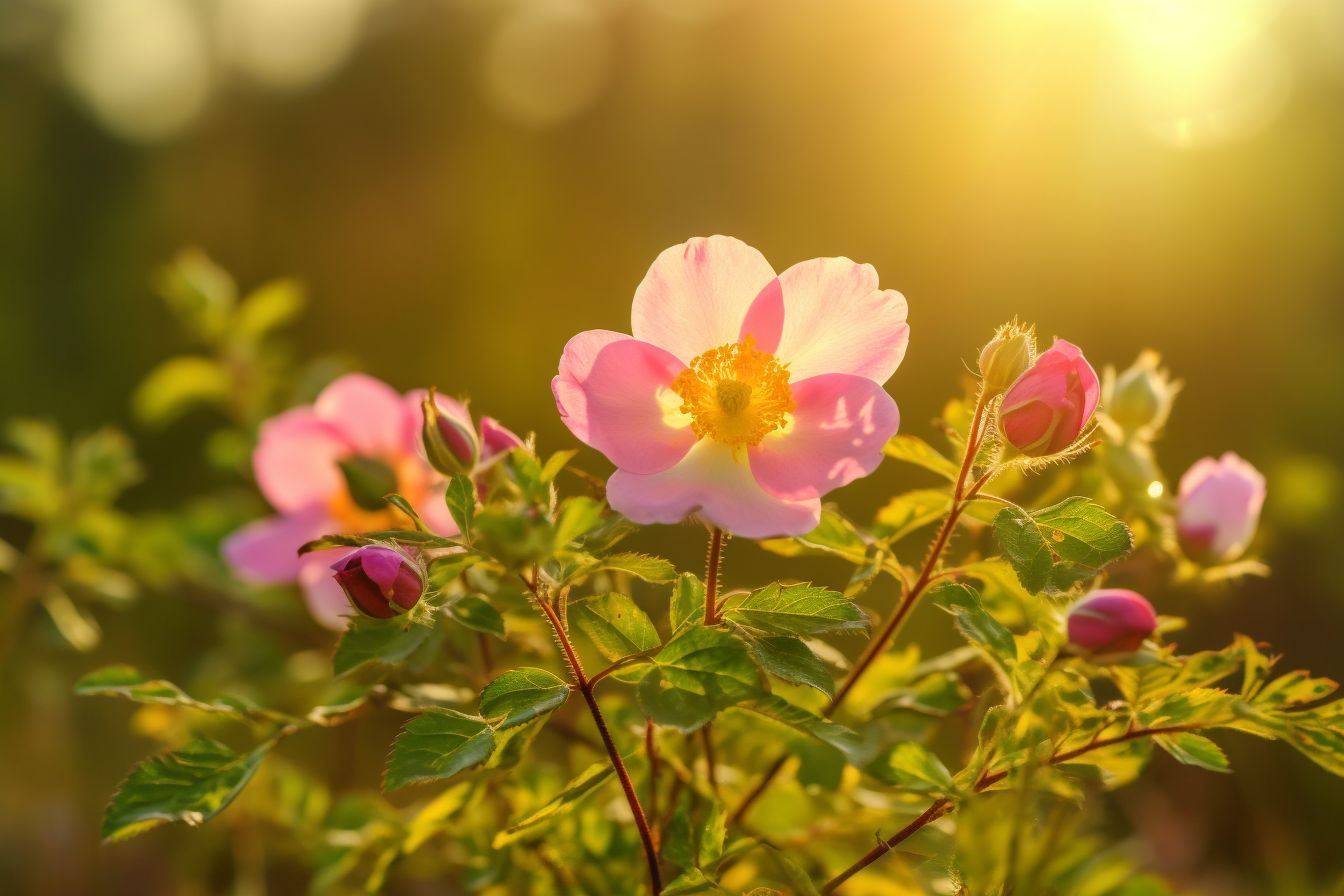Are you looking for flowers that symbolize freedom and independence? Look no further! Flowers have long been used as symbols of various emotions, and independence is no exception.
Whether you’re celebrating your own independence or that of someone you know, these 10 flowers are sure to represent the spirit of freedom and self-reliance.
Join me as we explore the meanings behind these beautiful blooms.
Black-Eyed Susan

Black-eyed Susan (Rudbeckia hirta) is a wildflower native to North America and is also known as the “gloriosa daisy.”
It is a hardy and resilient plant that can grow in a wide range of conditions, including drought and poor soil. This flower symbolizes independence because of its ability to thrive and survive on its own without much assistance or care from humans.
The black-eyed Susan has bright yellow petals that surround a dark brown, almost black, center. It blooms in mid to late summer and is often used in wildflower meadows or as a border plant. Its cheerful and vibrant appearance reflects the spirit of independence and self-sufficiency.
In Native American culture, black-eyed Susan is considered a symbol of encouragement and motivation, representing the ability to persevere through challenging times. It is said to bring good luck and positive energy to those who cultivate and care for it.
This flower’s resilience and ability to thrive in harsh conditions make it a perfect representation of independence and self-reliance.
Queen Anne’s Lace

Queen Anne’s lace, also known as wild carrot, is a delicate, lacy white flower that represents independence. The flower’s name is derived from Queen Anne of England, who was known for her skill in lace-making.
Queen Anne’s lace is a wildflower that grows freely in many regions of the world, and its ability to thrive in a variety of conditions has made it a symbol of resilience and independence.
The plant’s ability to survive and flourish in less than ideal conditions is a testament to its strength and perseverance. Queen Anne’s lace is also known for its ability to self-seed, allowing it to spread and grow on its own without much human intervention.
This quality of the flower has made it a symbol of self-sufficiency and independence.
In addition to its symbolic meaning, Queen Anne’s lace has been used in traditional medicine for centuries.
The plant has been used to treat a variety of ailments, including menstrual cramps, digestive issues, and urinary tract infections. Its medicinal properties have also contributed to its reputation as a symbol of self-reliance and independence.
Overall, Queen Anne’s lace is a beautiful and meaningful flower that represents the idea of independence and resilience.
Its ability to grow and thrive in a variety of conditions, along with its traditional medicinal uses, make it a fitting symbol for those who value self-sufficiency and the ability to overcome obstacles.
Purple Coneflower

Purple coneflower, also known as echinacea, is a beautiful flowering plant native to North America that represents independence.
This hardy plant is known for its resilience and ability to thrive in a variety of conditions, symbolizing the strength and independence that is often associated with this flower.
In Native American culture, echinacea was used for medicinal purposes to boost the immune system and ward off illness. This association with health and strength further emphasizes the flower’s representation of independence.
Purple coneflowers are also notable for their unique appearance. Their bold, vibrant colors and distinctive cone-shaped centers make them stand out in a garden or field, reflecting the idea of individuality and standing out from the crowd.
Overall, the purple coneflower is a beautiful and meaningful representation of independence and the strength and resilience that comes with it.
Wild Rose

Wild rose, also known as species rose, is a flower that represents independence. Unlike cultivated roses, wild roses grow naturally and are not dependent on human intervention to thrive. These hardy plants are known for their resilience and ability to adapt to various environmental conditions.
Wild roses come in a variety of colors, including white, pink, and red. They have five petals and are usually clustered together in groups of three or five.
The flower is also known for its sharp thorns, which protect it from predators and give it a sense of strength and self-sufficiency.
In addition to their physical characteristics, wild roses have a rich cultural history that represents independence. They have been used in traditional medicine and have been used symbolically in literature, art, and mythology to represent strength, freedom, and self-reliance.
The rose’s ability to survive and thrive in the wild has made it a symbol of resilience and independence.
Yarrow

Yarrow is a hardy perennial flower that is native to North America, Europe, and Asia. It is a member of the aster family and is known for its delicate, fern-like leaves and clusters of small, tightly packed flowers that bloom in a range of colors, from white to pink to yellow.
Yarrow has long been associated with independence and self-reliance. In ancient times, it was believed that carrying yarrow could protect against evil and increase courage.
In traditional Chinese medicine, yarrow is used to treat a variety of ailments, including fever, digestive issues, and menstrual cramps.
Yarrow’s ability to thrive in a wide range of growing conditions, from poor soil to drought, is also seen as a symbol of independence.
It is often used in natural medicine and aromatherapy, and its leaves and flowers are brewed into tea, infused into oils and tinctures, and used in baths and compresses.
The strong, upright stems of yarrow are also said to represent strength and resilience, making it a popular choice for gardens and landscaping.
Overall, yarrow is a powerful symbol of individuality and self-sufficiency, making it an ideal flower for those who value their independence.
Honeysuckle

Honeysuckle is a flower that represents independence due to its ability to thrive and grow without much human intervention.
This perennial vine can climb up to 30 feet in height and spread out several feet wide, and it has a sweet fragrance that attracts bees and other pollinators.
In addition, honeysuckle is known for its hardiness and adaptability, making it a symbol of resilience and self-sufficiency. It can survive in a variety of soil types and climate conditions, and is often found growing along roadsides, in forests, and in other natural habitats.
The honeysuckle flower is also associated with independence in Chinese culture, where it is seen as a symbol of devotion and freedom.
In traditional Chinese medicine, honeysuckle is used to treat a variety of ailments, including colds, fevers, and sore throats, reflecting its healing and restorative properties.
Overall, honeysuckle’s ability to grow and thrive on its own, as well as its association with resilience and self-sufficiency, make it a flower that represents independence.
Globe Thistle

Globe thistle, also known as Echinops, is a unique and eye-catching flower that represents independence. This plant is known for its spiky, spherical blooms that are made up of hundreds of tiny, metallic blue flowers.
The flower heads can reach up to three inches in diameter and are surrounded by spiny bracts, giving the plant a distinctive, almost otherworldly appearance.
Globe thistle is a tough and resilient plant that can thrive in harsh environments and is resistant to many pests and diseases. Its ability to grow and flourish even in difficult conditions is a metaphor for the independent spirit, strength, and resilience that are necessary for success in life.
Additionally, the striking appearance of the globe thistle is a symbol of uniqueness and individuality. The flower’s spiky, textured appearance and vibrant blue color make it stand out from other flowers in a garden.
This can represent the idea that being independent often means standing out from the crowd and being true to oneself, rather than conforming to the expectations of others.
Overall, globe thistle is a flower that represents the idea of independence as a source of strength, resilience, and individuality.
Lupine

Lupine is a wildflower native to North America that grows in a variety of colors such as pink, blue, purple, and white. It is a flower that represents independence due to its ability to thrive in harsh conditions and its self-sufficiency.
Lupines have long taproots that allow them to reach water deep in the soil, making them highly drought-resistant. They also have a unique ability to fix nitrogen in the soil, making them self-sufficient and reducing the need for added fertilizers.
Lupines are also known for their ability to grow in poor soil conditions and their adaptability to various climates. This ability to adapt and survive on their own makes them a symbol of independence.
In addition to their physical characteristics, lupines have also been used symbolically by Native American cultures to represent independence and self-reliance. The plant has been used in traditional medicine and in ceremonies to promote strength and independence.
Overall, lupine is a powerful symbol of independence due to its resilience and self-sufficiency in even the harshest of conditions.
Goldenrod

Goldenrod is a bright and cheerful wildflower that symbolizes independence. This flower is known for its ability to thrive in a variety of environments and conditions, making it a symbol of resilience and adaptability.
Goldenrod is also associated with individuality and self-sufficiency, as it grows and spreads independently without the need for additional support or intervention.
The bright yellow blooms of goldenrod are often seen in late summer and early fall, providing a burst of color and energy during a time of transition.
This timing is significant, as it suggests that goldenrod is a flower that represents the ability to navigate change and uncertainty with confidence and independence.
In addition to its symbolic meaning, goldenrod has also been used for its medicinal properties for centuries. It is believed to have anti-inflammatory and immune-boosting properties, making it a valuable resource for those looking to maintain their health and well-being independently.
Overall, goldenrod is a powerful symbol of independence and the ability to thrive in challenging conditions.
Whether used as a decorative plant or as a medicinal herb, this flower serves as a reminder of the strength and resilience that can be found within each of us.
Red Poppy

The red poppy is a flower that has been associated with independence and freedom, particularly in Western culture.
This association is due in part to the fact that the flower is often used as a symbol for veterans and fallen soldiers, particularly in the context of World War I and World War II.
In many countries, the red poppy is worn on Remembrance Day (also known as Armistice Day), a holiday that commemorates the end of World War I and honors those who have died in military service.
The tradition of wearing a red poppy on this day originated from the poem “In Flanders Fields” by Canadian physician Lieutenant Colonel John McCrae, which describes the poppies that grew on the battlefields of World War I.
The red poppy is also associated with independence and freedom because of its ability to grow in harsh and inhospitable environments. The plant is able to thrive in disturbed soil and is often found growing in areas that have been affected by war or other human activities.
Its bright red color and delicate petals also evoke feelings of strength and resilience, making it a fitting symbol for those who have fought for their independence and freedom.

My name is Daniel Elrod, and I have been houseplant love ever since I was 17. I love how much joy they bring to any room in the home. I’ve always been amazed at how a few pots of flowing leaves can turn a drab and sterile office into an inviting place where people love to work at.
















